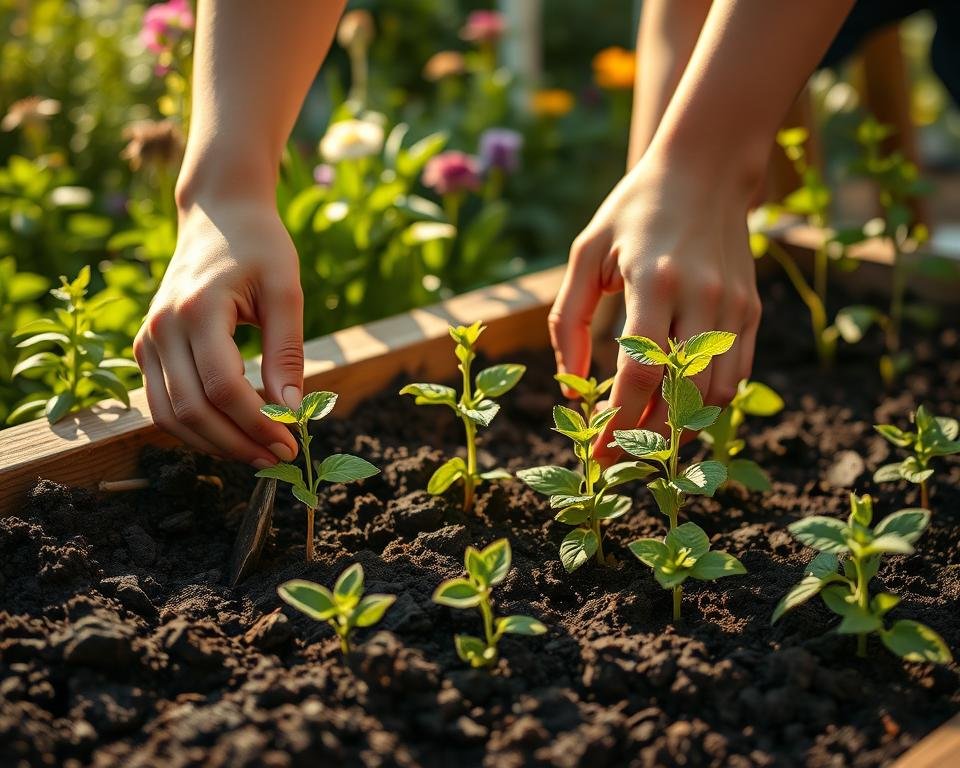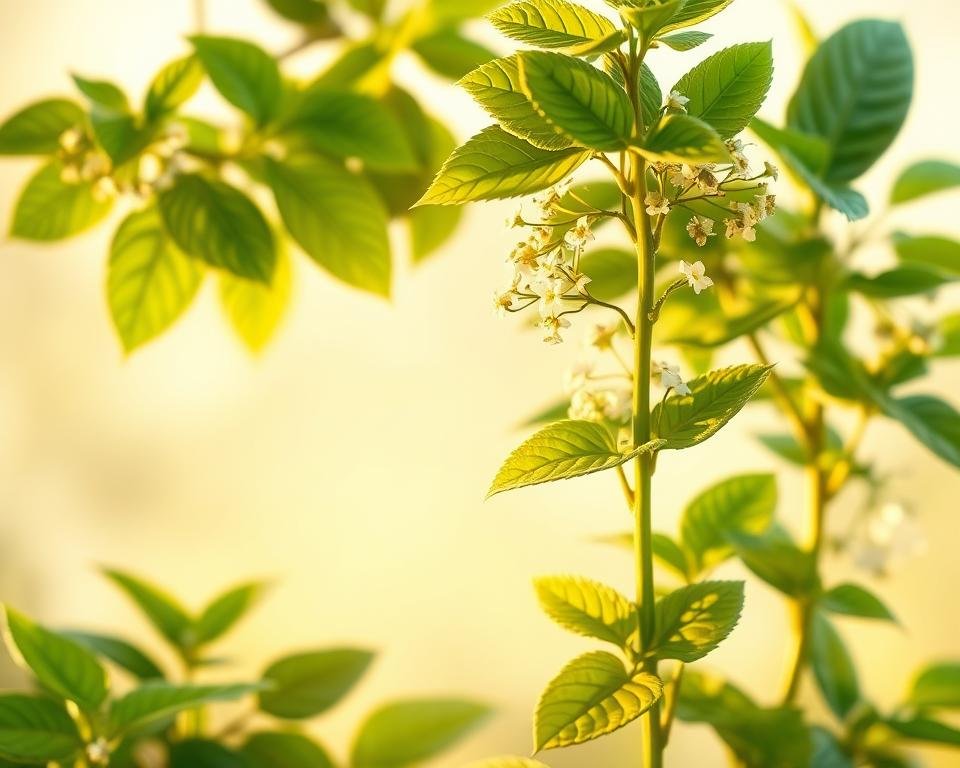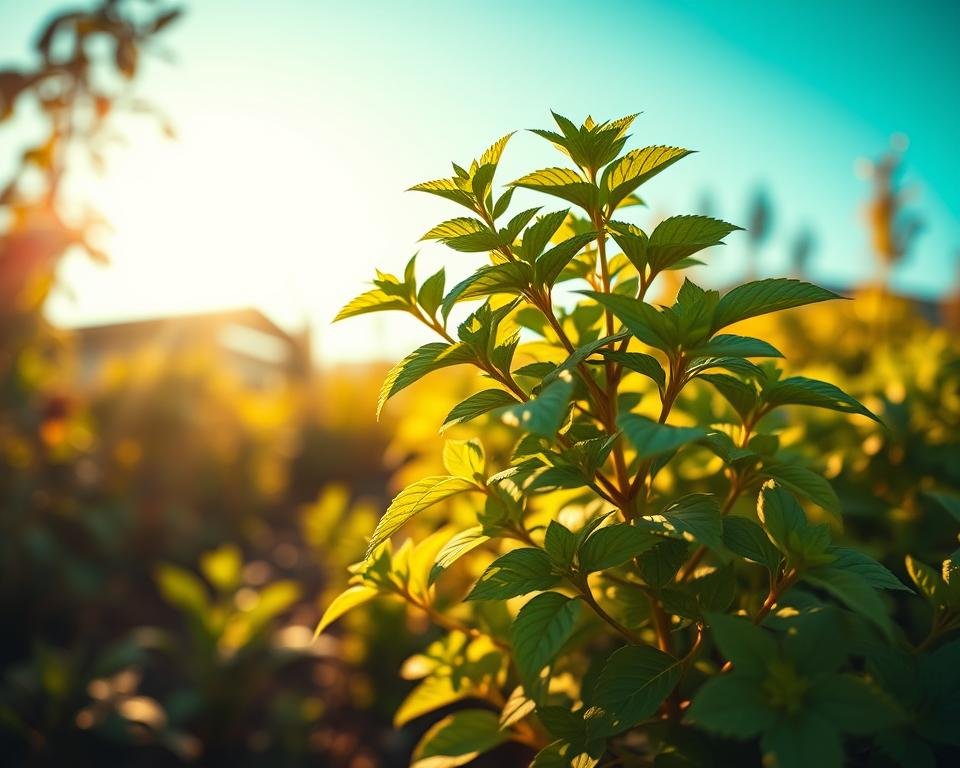Discover How to Grow Lemon Herbs Plants Everyone Is Using
There’s something magical about stepping into a garden filled with fragrant leaves. One whiff of lemon balm, and you’re transported to a sunny orchard. This vibrant herb, with its bright green foliage and delicate flowers, brings both beauty and purpose to any space.
Belonging to the mint family, this versatile plant thrives effortlessly. Whether you’re brewing a calming tea or adding zest to summer recipes, its citrusy aroma elevates everyday moments. Gardeners love it for its adaptability—flourishing in various climates with minimal fuss.
Beyond the kitchen, lemon balm serves as a natural pest deterrent and even stars in DIY beauty treatments. Its dual-purpose nature makes it a favorite among herb enthusiasts. Let’s explore how this garden gem can transform your outdoor space and daily rituals.
Key Takeaways
- Lemon balm offers a refreshing citrus scent and visual appeal.
- Ideal for both culinary dishes and soothing herbal teas.
- Low-maintenance and adaptable to different growing conditions.
- Doubles as a natural pest repellent and skincare ingredient.
- Perfect for beginners and experienced gardeners alike.
Why Lemon Balm Is the Must-Have Herb for Your Garden
Few garden additions blend beauty and function like lemon balm. This mint-family favorite delights with lush foliage and a refreshing citrus-mint scent. Beyond looks, it’s a powerhouse for pollinators and practical garden solutions.
Bees and butterflies flock to its tiny white flowers, making it a star in pollinator-friendly gardens. Unlike regular mint, it spreads modestly by seeds—not aggressive runners. Perfect for borders or containers, it adapts to zones 4–11 with winter mulching.
We crush leaves during gardening to repel mosquitoes naturally. The aroma also elevates outdoor spaces, doubling as a stress-relieving fragrance. Historically, apothecaries prized it for calming teas and remedies.
| Feature | Lemon Balm | Regular Mint |
|---|---|---|
| Spread Method | Seeds | Runners |
| Height | 24–36″ | 12–24″ |
| Maintenance | Low | Moderate |
| Best For | Containers, borders | Controlled beds |
Pair it with tomatoes or roses to deter pests organically. Its vigor and dual-purpose nature make it a top pick for beginners and experts alike. Whether in pots or plots, lemon balm earns its spot in every garden.
Getting Started: Choosing the Right Lemon Balm Variety
Golden leaves or bold citrus scent? Your lemon balm variety shapes your garden’s vibe. Seed-grown cultivars often surprise with unique flavors, while nursery starters like Bonnie Plants ensure consistency. Sniff and taste leaves before buying—some pack more zing than others.
Popular picks include ‘Aurea’ for golden foliage and ‘Citronella’ for intense aroma. Specialty types like ‘Lime Balm’ offer quirky twists. Compact cultivars suit pots, while spreading ones fill garden borders.
| Variety | Key Trait | Best Use |
|---|---|---|
| ‘Aurea’ | Golden leaves | Ornamental gardens |
| ‘Citronella’ | Strong scent | Pest repellent |
| ‘Lime Balm’ | Mild lime flavor | Cocktails, salads |
| ‘Quedlinburger’ | Disease-resistant | Humid climates |
Seeds take 7–14 days to sprout at 70°F but may yield uneven flavor. For reliability, opt for seedlings—especially in cooler zones. Southern gardeners should prioritize heat-tolerant types.
Fuzzy leaves? That’s normal for some cultivars. Avoid invasive lookalikes by checking leaf edges—true lemon balm has scalloped margins. Whether for tea or garnishes, picking the right cultivar ensures success.
How to Grow Lemon Herbs Plants Everyone Is Using
Timing and conditions make all the difference for thriving lemon balm. Whether you’re starting seeds or transplanting, these fundamentals set the stage for success.
When to Plant Lemon Balm
Wait until after the last frost in spring for outdoor planting. Cold soil stunts growth, so check local frost dates using USDA zone maps. In warmer zones (7–11), fall planting works too.
Pro tip: Winter sowing mimics natural cold stratification. Scatter seeds in pots outdoors—they’ll sprout when temperatures rise.
Ideal Soil Conditions
Lemon balm loves well-draining soil with a pH of 6.5–7.0. Mix in compost for nutrients and moisture retention. Avoid heavy clay—it drowns roots.
- Test soil with a kit from garden centers.
- Amend sandy soil with peat moss for better water retention.
Sunlight and Shade Requirements
Plant in full sun (6+ hours daily) for bushy growth. In hot climates, afternoon shade prevents leaf scorch. Containers let you move plants for optimal light.
Indoors? Place near south-facing windows. Rotate pots weekly for even growth.
Planting Lemon Balm: Step-by-Step Guide
A thriving herb garden starts with proper planting techniques. Whether you begin with seeds or seedlings, these steps ensure robust growth and aromatic leaves.

Starting from Seeds vs. Seedlings
Seedlings jumpstart your garden, while seeds offer budget-friendly variety. Here’s how to choose:
- Cost: Seed packets ($2) vs. nursery plants ($5).
- Timeline: Start seeds indoors 8 weeks before transplanting.
- Success rate: Seedlings adapt faster to the ground.
Pro tip: Soak seeds overnight to boost germination. Use a heat mat if temps dip below 70°F.
Spacing Your Plants
Give plants room to flourish. Space them 20–24 inches apart to prevent competition for sunlight and nutrients.
For containers, pick pots at least 12″ wide. Crowded roots stunt growth and reduce leaf yield.
Caring for Your Lemon Balm Plants
Healthy lemon balm plants reward you with lush foliage and vibrant flavor. With minimal effort, they thrive through the growing season, offering endless harvests. Here’s how to keep them at their best.
Watering Tips
Check soil moisture by sticking your finger 1″ deep. Water only if it feels dry. Overwatering causes yellow leaves—a sign to ease up.
Drip irrigation delivers steady moisture without waste. Hand-watering works too, but avoid wetting leaves to prevent mildew.
Fertilizing for Maximum Growth
Feed plants every 4–6 weeks with Miracle-Gro Performance Organics. This boosts leaf production without harsh chemicals.
In early spring, mix compost into soil. It enriches nutrients naturally, supporting strong growth.
Pruning and Maintenance
Trim stems to 6–8″ in midsummer to rejuvenate lemon balm. Regular harvesting doubles as pruning, keeping plants bushy.
Remove flower buds to prolong leaf flavor. Left unchecked, they signal the end of the growing season.
“Pruning isn’t just maintenance—it’s an invitation for fresh growth.”
Common Problems and How to Solve Them
Even the hardiest herbs face challenges, but solutions are simpler than you think. With quick action, your lemon balm stays lush and productive all season.
Pests and Diseases
Tiny invaders like aphids or whiteflies sometimes target plants. Inspect leaves with a magnifier—clusters under foliage signal trouble.
Mix 1 tsp neem oil with a quart of water for a safe spray. This organic remedy deters pests without harming pollinators.
Humidity breeds powdery mildew. Space stems properly for airflow, and water at the base to keep leaves dry.
Controlling Spread
As a mint family member, lemon balm can self-seed aggressively. Prune flower buds before they mature to limit volunteers.
For garden beds, edge with buried barriers or grow in pots. Gravel layers at container bottoms prevent root rot while curbing expansion.
“Prevention beats cure—regular checks stop small issues from becoming big headaches.”
When and How to Harvest Lemon Balm
Harvesting at the right moment unlocks the herb’s full potential. Timing and technique determine whether your balm leaves burst with flavor or fall flat. Let’s explore the secrets to a perfect harvest.
Best Time to Harvest
Essential oils peak just before flowering. Look for buds forming but not yet open—this is the time to act. Morning cuts preserve oils, as dew evaporates and leaves are plump.
Spring yields tender stems, while fall harvests offer robust flavor. Avoid rainy days; moisture dilutes potency. For continuous growth, never remove more than one-third of the plant.
Harvesting Techniques
Use sharp scissors to snip stems 6–8 inches long. Cut above a leaf node to encourage bushier growth. Angle cuts at 45 degrees to prevent water pooling.
- For drying: Bundle 5–6 stems with twine, hang upside down in shade.
- Fresh use: Place balm leaves in a jar of water (like flowers) to extend freshness.
“A gentle touch preserves the plant’s vitality—harvest with care, and it will reward you all season.”
Preserving Lemon Balm for Long-Term Use
Capture summer’s zest year-round by preserving lemon balm leaves at their peak. Proper techniques maintain their citrusy flavor and aromatic qualities for teas, recipes, and remedies.

Drying Leaves
Sun-drying works best with stainless steel pans. Spread leaves in a single layer and place in direct sunlight for 2-3 days. For faster results, use a dehydrator at 130°F for 4-6 hours.
- Test dryness by crinkling leaves—they should crack, not bend
- Store in airtight glass jars away from light to preserve flavor
- Label with dates; best used within 12 months
Freezing and Other Methods
For fresh-tasting lemon balm leaves, freeze them in ice cube trays with water. Alternatively, layer whole leaves between parchment paper in a freezer-safe pot.
“Frozen herbs retain more volatile oils than dried—perfect for sauces and cocktails.”
Oil infusion offers another option. Pack clean leaves in a jar, cover with olive oil, and steep for 2 weeks. Strain and use for cooking or skincare.
Culinary Uses for Lemon Balm
Bright citrus notes transform ordinary meals into vibrant culinary experiences. This versatile herb works equally well in sweet desserts and savory entrees, making it a kitchen staple. Whether fresh or dried, its leaves impart a distinctive flavor that complements various ingredients.
Fresh Applications
For maximum zest, add leaves just before serving. They shine in:
- Fruit salads – Pair with watermelon and feta for a refreshing summer dish
- Herbal mojitos – Substitute mint in cocktails for a citrusy twist
- Infused waters – Steep leaves in iced tea or lemonade overnight
The tender young leaves have the most delicate flavor. Crush them gently to release aromatic oils when garnishing dishes.
Heat-Infused Creations
Cooking mellows the herb’s intensity while preserving its character. Try these techniques:
| Method | Best Pairings | Pro Tip |
|---|---|---|
| Sautéing | Chicken, white fish | Add in last 2 minutes |
| Baking | Shortbread, scones | Mix chopped leaves into dough |
| Steeping | Soups, sauces | Remove leaves after 5 minutes |
For fruit-based desserts, layer leaves between berries before baking. The heat intensifies their citrus notes beautifully.
“Lemon balm bridges the gap between herbs and citrus—it’s nature’s two-in-one seasoning.”
Remember that prolonged heat diminishes flavor. Always use lemon balm as a finishing touch for cooked dishes to preserve its bright profile.
Medicinal Benefits of Lemon Balm
Modern science confirms what herbalists knew about this fragrant powerhouse. Lemon balm offers proven therapeutic properties that soothe both body and mind. Research validates its traditional uses for relaxation and skin health.

Calming Teas and Tinctures
Steep fresh leaves for 15 minutes to extract maximum calming compounds. This herb contains rosmarinic acid, shown to reduce anxiety in clinical studies.
- Alcohol tinctures preserve volatile oils better than glycerin versions
- Standard dose: 300-600mg capsules or 30 drops liquid extract
- Combine with chamomile flowers for enhanced sleep support
“Nightly lemon balm tea improved my sleep quality within 3 days—no grogginess like prescription aids.”
Topical Applications
Crushed leaves make effective cold sore compresses. The herb‘s antiviral properties combat HSV-1 when applied early. Test a small skin patch first to check for sensitivity.
For DIY salves, infuse dried leaves in coconut oil for 2 weeks. This creates a versatile skin-soothing remedy for minor irritations and insect bites.
Creative Ways to Use Lemon Balm
Beyond the garden, lemon balm shines in creative projects. Its vibrant leaves and refreshing aroma make it perfect for home crafts and self-care routines. We love finding new ways to enjoy this versatile herb.
Home and Garden Decor
Fresh stems add life to floral arrangements. Combine them with roses and lavender for a fragrant bouquet that lasts up to five days. Change the water daily to extend freshness.
For seasonal decor, try these ideas:
- Wreaths: Weave stems into grapevine bases for a welcome addition to front doors
- Potpourri: Mix dried leaves with rose petals and citrus peels (see blend ratios below)
- Centerpieces: Float leaves in shallow bowls with candles for evening gatherings
| Potpourri Blend | Lemon Balm | Companion Ingredients | Scent Profile |
|---|---|---|---|
| Spring Fresh | 1 cup | ½ cup lavender + ¼ cup mint | Floral-herbal |
| Citrus Spice | ¾ cup | ½ cup orange peel + 2 cinnamon sticks | Warm & bright |
| Calming Mix | 1¼ cups | 1 cup chamomile flowers | Soft & soothing |
DIY Beauty and Bath Products
The herb’s natural properties work wonders in skincare. Try this simple bath soak:
- Combine ½ cup Epsom salts with ¼ cup dried leaves
- Add 10 drops of lemon essential oil to intensify the scent
- Store in a glass pot for up to three months
For glowing skin, steep fresh leaves in hot water. Once cooled, use as a facial toner. The antioxidants help reduce redness and irritation.
“My homemade lemon balm bath salts became a nightly ritual—they ease muscle tension better than store-bought versions.”
Create a fresh-scented hair rinse by boiling leaves in apple cider vinegar. Strain after cooling, then dilute with water. This clarifies scalp buildup naturally.
Lemon Balm Companion Planting
Strategic pairings transform ordinary gardens into thriving ecosystems. When lemon balm shares space with the right neighbors, it repels squash bugs and attracts predatory wasps naturally. These partnerships reduce pesticide needs while boosting biodiversity.
- Tomatoes – Balm deters hornworms while tomatoes provide shade
- Brassicas (cabbage, kale) – Mutual pest protection against whiteflies
- Fruit trees – Attracts pollinators for better fruit set
Some plants compete aggressively or cross-contaminate flavors. Avoid planting near:
- Other mint family members (competes for nutrients)
- Invasive herbs like creeping thyme (space conflicts)
- Delicate seedlings (balm’s vigorous growth overwhelms them)
Border planting creates natural pest barriers. Edge vegetable beds with lemon balm every 3-4 feet. This spacing allows airflow while forming a protective perimeter. For small gardens, alternate with marigolds for doubled defense.
| Season | Best Intercropping Partners | Benefit |
|---|---|---|
| Spring | Lettuce, spinach | Shade protection from bolting |
| Summer | Peppers, eggplant | Deters flea beetles |
| Fall | Brussels sprouts | Confuses cabbage moths |
“My tomato yield increased 20% after bordering with lemon balm—the wasps it attracted devoured every caterpillar.”
Rotate companions annually to prevent soil depletion. Track pairings in a garden journal to identify your most successful combinations.
Conclusion
From seedling to harvest, lemon balm brings joy at every stage. Its resilience makes it perfect for first-time gardeners and seasoned growers alike. We’ve shared tips to help your plants thrive in any garden.
Try drying leaves or freezing them—each method unlocks unique flavors. This herb bridges generations, offering shared moments in the kitchen and outdoors. Did you create a standout recipe? Share your success with fellow enthusiasts!
Remember, a single lemon balm plant yields enough leaves for dozens of teas. Start small, and let its citrusy charm inspire your next green adventure.







